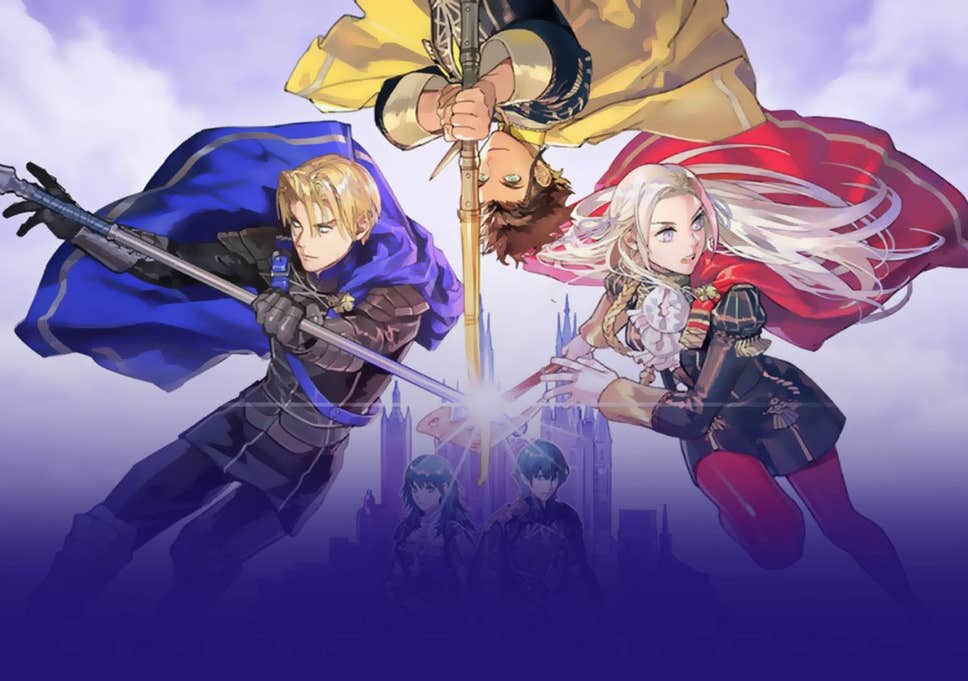|
I’ve talked before about borrowing plots from video games, citing that both video games and tabletop roleplaying games are similar media. A scenario is set forth to the players, they give direction to a character or other entity they control, and the state of the scenario is updated based on that input. The primary difference between the two often comes down to input methods, and what entity is doing the parsing of these commands. I digress, though. Today, I want to discuss with you some of the fantastic settings in the realm of video games. This list is of course by no means exhaustive, but each of these on this list were chosen because of how unusual they are compared to the so called “standard fantasy” that is Dungeons and Dragons. So, for your reading pleasure, I present to you: 5 Unusual Video Game Settings You Should Play Your Next Game In! 1) Fire Emblem Fire Emblem has recently become one of Nintendo’s hottest franchises; there’s numerous games in the series, and every one of them boasts a huge cast of characters. Some people love Fire Emblem for these huge casts of characters, as well as the ability to see how certain character’s relationships bud through the course of the story. This is a story that is told between numerous tactical battles, pitting one army against another, with false steps often leading to characters permanently being lost. Most stories in Fire Emblem showcase different conflicts between neighboring countries, and ultimately climax with a battle between good and evil after the powers of some mythic artifact has been discovered. (Such as the titular Fire Emblem.) While it’s often lampooned for being formulaic, this is precisely what makes it easy to emulate in a tabletop roleplaying game! So How Would You Do It? You can easily recreate something like Fire Emblem using Dungeons and Dragons if you play up the tactical combat element; interesting terrain and fighting to secure important strategic locations. Players would be restricted to playing Humans, since other races like dragons or werewolves are the stuff of legend, and most conflict is between humans. However, Fire Emblem is known to take place over a massive scale. Casts range upwards of the 20s or even 30s in some games. To make this sort of campaign work, occasionally, the war would need to be fought on more fronts, and players would take control of a different cast of characters aiding a different theatre in the war effort. 2) Sunless Sea / Fallen London Sunless Sea and Fallen London are part of a gothic horror series of games by Failbetter Games; they both play like choose-your-own-adventure books, though the aforementioned also has extra gameplay elements that make sense with its nautical namesake. They take place out of the city of London, in an alternate timeline where Hell literally broke loose, and London sank beneath the waves. The Londoners have adapted to their strange new biome, where darkness warps reality, one’s neighbors could literally be devils, maps have become useless, and sunlight, should one happen to find your way back to the surface, is as lethal as it is pleasant. (That is to say, very, on both accounts.) So How Would You Do It? Combat in Fallen London is meant to be a dangerous prospect. Sure, you can easily beat up other mortals, but the world is rife with all kinds of creatures that seem familiar, but defy all reason. These otherworldly creatures? They never truly die; if they hit 0 HP or are otherwise defeated, they just fade back to where they came from, and they’ll come back later. When they do return, they’ll be bigger, stronger, and still nursing the grudge from their previous loss. Furthermore, one of the laws of reality in Fallen London is that light brings order to the world. Because of this, even if you somehow can see in the dark, you want light. Light from torches, oil and gas lamps, or even just starting fires; because the darkness doesn’t just hide monsters, it stains the very fabric of reality. 3) Super Mario The Mario Brothers are a duo that need no explanation at this point. “Duh-duh duh duh-duh duh duh” is a line almost anybody in the developed world can sing out loud properly. That isn’t to say there isn't any interesting to discuss in the Super Mario lore; as time went on and Nintendo tried new things with the franchise, more characters got added, and they each wound up with their own shticks and spinoff games. Spinoffs such as Luigi’s Mansion and Wario World. Two such spin offs I want to bring attention to are Paper Mario and Mario and Luigi: Super Star Saga; video game RPGs that are very whimsical with rather expansive worlds, filled with all kinds of unusual creatures and environments. It’s the perfect setting for those “Only boring people play human” types!” So How Would You Do It? The Mario RPG video games are very gamey, with the occasional nod to new abilities gained over the course of play being usable to solve puzzles outside of combat. This isn’t a setting that lends itself to ruleslite games, but does have a wide variety of different mechanics through the series, so any sort of home-brewing of a crunchy game will do. (Or you can play this D&D 3.5 adaptation!) 4) Seiken Denetsu / The “Mana” Series This is one of my favorite video game series of all time. When I hear the phrase “High Fantasy,” this is what comes to mind. A world with magic abound, and all manner of unusual creatures, friendly or otherwise, and clear divides of good and evil optional, depending on the entry in the series. The timeline of the series is fairly long, starting with a cataclysmic war that didn’t quite destroy the world, but definitely wiped out the existence of magic. However, as the series goes on, magic eventually begins finding its way back into the world, with constant allusions back to that war, such as an empire trying to rebuild the technology that made the war possible, as well as junkyards filled with ancient relics from that war. (Some of which are still alive, and resentful of being left to rot!) So How Would You Do It? It’s a bad idea to try and emulate video game mechanics in tabletop form, especially on a one-to-one scale. Computers can handle large numbers and operations much more accurately than your average human. However, since even the Mana games have wildly different mechanics, mechanical accuracy can be forgone. My choice for trying to recreate the Mana series would be Anima: Beyond Fantasy. Since it has rules for creating fantastic creatures, as well as possessing various rules for all kinds of different supernatural powers. Even though magic is prevalent in the Mana series, there is still plenty of allusions to other forces as well, and the backbone Anima’s magic system relies on the JRPG fantasy staple of the four classical elements, plus light and dark. The triple digit arithmetic will just have to be something you adapt to. (Think of it as an opportunity to practice mathematics!) 5) Hylics Please don’t try this. (Warning: weird and a little gross) So How Would You Do It? No. Seriously. This is a bad idea. Did you not pay attention to entry 4? Sometimes you have to be willing to make sacrifices because concepts don’t always translate between media. This is why some movies drop scenes that were in the book they’re adapted from. Other times, you simply shouldn’t try because what makes the game truly unique, simply can’t be recreated. Or what you’re trying to recreate is just a fever dream. Aaron der Schaedel actually really likes Hylics, but realizes part of its charm is the surreal world it’s set in. It’s a quality that doesn’t quite come across as well in the spoken or written word, and is probably best left to the realm of other visual arts. Here’s a shameless plug for his YouTube channel. Picture Reference: https://www.independent.co.uk/life-style/gadgets-and-tech/gaming/fire-emblem-three-houses-rpg-review-strategy-professor-combat-nintendo-switch-a9021831.html
How dare you mention Paper Mario and Mario & Luigi but not the original Super Mario RPG >.<!!! All kidding aside I love both of those franchises, but I do wish we'd one day get a true SMRPG sequel.
Reply
8/12/2020 10:41:43 pm
Reply
26/9/2022 03:28:42 pm
These were the games that I used to play as a kid. I can still picture myself just playing inside our house and not having a care in the world. I know that it will take a lot of time before I can truly enjoy myself, but believe me, I am trying. I know that it is hard to go and think about what you need to do, but believe me, everything is just bound to get better for you. You just need to believe in yourself.
Reply
22/3/2023 05:14:47 am
Get reliable, fast, and secure <a href="https://realmshosting.com/fivem/"><b>fivem servers hosting</b></a> with 24/7 support. We offer top-notch servers with unbeatable performance and scalability to ensure your gaming experience is the best it can be.
Reply
15/5/2023 10:17:24 am
Before using a VPN with Warzone, it's essential to research and choose a reputable VPN service that offers good performance and has servers located near the game servers you plan to connect to. It's also crucial to understand and comply with the game's terms of service to avoid any potential issues with your account.
Reply
18/10/2023 10:44:12 pm
Exploring new and unusual video game settings is a passion for many of us, and I'm delighted to see a blog post highlighting "4 Unusual Video Game Settings You Can Play Your Next Game In." It's a breath of fresh air in the gaming world when we can step into unique and unexpected environments. This blog continues to fuel my excitement for gaming and inspires me to broaden my horizons. I can't wait to dive into these unusual settings for my next gaming adventure.
Reply
14/7/2024 12:35:16 pm
The cultural impact of gaming cannot be understated. Characters like Mario, Link, and Lara Croft have become iconic, recognized even by those who may never have played the games themselves. These characters and their stories have influenced other media, inspiring movies, television shows, and even fashion. Gaming has also sparked debates and discussions about its influence on behavior and society, from concerns about addiction and violence to its potential as a tool for education and positive change. The medium’s ability to evoke strong emotional responses and create memorable experiences makes it a powerful cultural force.
Reply
20/7/2024 03:22:18 am
The technological advancements in gaming hardware have also been remarkable. The transition from 8-bit graphics to high-definition visuals has been a testament to the industry's continuous innovation. Modern consoles like the PlayStation 5 and Xbox Series X boast powerful processors and graphics capabilities, delivering lifelike visuals and seamless gameplay. Furthermore, the development of virtual reality (VR) and augmented reality (AR) has opened up new possibilities for immersive experiences. VR headsets transport players into fully realized virtual worlds, while AR blends digital elements with the real world, creating unique and interactive experiences. These technologies are pushing the boundaries of what is possible in gaming, promising an exciting future for the medium.
Reply
Leave a Reply. |
All blog materials created and developed by the staff here at High Level Games Archives
April 2023
Categories
All
|
Proudly powered by Weebly




 RSS Feed
RSS Feed